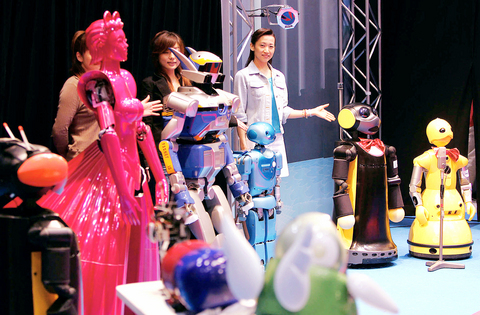Robots of all shapes and sizes were batting fastballs, drawing portraits, teaching the waltz and doing standup comedy at the World Expo -- but several years of testing are still needed before most of them can be used in public, developers say.
Lined up in a row of booths, the more than 60 robots on display starting Thursday at the Prototype Robot Exhibition -- being held in a corner of the sprawling expo in Aichi, in central Japan -- are designed to become part of everyday lives, helping the sick, rescuing disaster victims and entertaining families.
The exhibit, which runs through June 19, aims to showcase Japan's leadership in robotics. With the nation's economy still sluggish, corporations, researchers and government officials are hoping the sector can provide new growth opportunities.

PHOTO: AP
The Japan Robot Association, a trade group, expects the Japanese market for next-generation robots -- those being developed now as opposed to industrial robots currently in use -- to grow to ?1.5 trillion (US$14 billion) by 2010, and to more than ?4 trillion (US$37 billion) by 2025.
But all the robots on display were test models, and researchers say it will still be several years until they can be used safely and reliably in public. Several robots had obvious glitches.
Cooper, a mechanical portrait artist developed by a candy maker, was drawing the faces of visitors on large cookies with a laser-pen. It has a program that translates images from a digital camera into line drawing instructions, but sometime the robot delivers only a mishmash of scribbles, said Yukata Saito, spokesman for developer Yoshikawa Kikai Seisakusho Corp.
Many of the robots were designed to help communication. One worked as a fancy videophone, replicating the moves of the distant caller with its mechanical arms and projecting a three-dimensional image of the caller on its face.
One model called Batting Robot has a vision system that handles 1,000 images a second, more than 30 times the human eye, allowing it to accurately hit pitches of up to 160kph. At the expo, however, it was using a plastic bat to hit rubber balls at far slower speeds.
Hiroshima University Associate Professor Idaku Ishii believes the robot can help train major league baseball players, although a more practical purpose is processing information at lightning speeds, such as detecting cracks in walls during an earthquake.
The exhibit boasts a lineup galore of entertainment robots.
Humanoids Robovie and Wakamaru have been programmed by a famous comedy agency to put on a slapstick routine.
A model called InterAnimal is a teddy bear about 120cm tall that moves its arms and nods in synch to the sound the human voice. Developers claim it helps children who have problems talking with adults.
The robot that looks most like a human being is the Repliee Q1expo, which is covered with a skin-like substance and moves its mouth and shifts its torso as though it's breathing. It also gives the illusion of reacting to approaching people.
But Repliee sometimes goes into what appears to be spasms when its program hits a glitch.
Still, it may be a precursor of the day when robots will be helping with tasks such as guiding the elderly around the streets or selling tickets, developers say.
"When a robot looks too much like the real thing, it's creepy," Osaka University Professor Hiroshi Ishiguro said. "But if they resemble human beings, it also makes communication easier."
More whimsical is the golden Kinshachi Robot that swims like a fish. The slithering robot has comical bulging eyes, but it has a serious purpose: To go into the ocean to monitor the safety of bridges and gather information for fishing, according to Ryomei Engineering Co., which also develops more lifelike carp and sea bream robots.

ECONOMIC WORRIES: The ruling PAP faces voters amid concerns that the city-state faces the possibility of a recession and job losses amid Washington’s tariffs Singapore yesterday finalized contestants for its general election on Saturday next week, with the ruling People’s Action Party (PAP) fielding 32 new candidates in the biggest refresh of the party that has ruled the city-state since independence in 1965. The move follows a pledge by Singaporean Prime Minister Lawrence Wong (黃循財), who took office last year and assumed the PAP leadership, to “bring in new blood, new ideas and new energy” to steer the country of 6 million people. His latest shake-up beats that of predecessors Lee Hsien Loong (李顯龍) and Goh Chok Tong (吳作棟), who replaced 24 and 11 politicians respectively

Archeologists in Peru on Thursday said they found the 5,000-year-old remains of a noblewoman at the sacred city of Caral, revealing the important role played by women in the oldest center of civilization in the Americas. “What has been discovered corresponds to a woman who apparently had elevated status, an elite woman,” archeologist David Palomino said. The mummy was found in Aspero, a sacred site within the city of Caral that was a garbage dump for more than 30 years until becoming an archeological site in the 1990s. Palomino said the carefully preserved remains, dating to 3,000BC, contained skin, part of the

Russian hackers last year targeted a Dutch public facility in the first such an attack on the lowlands country’s infrastructure, its military intelligence services said on Monday. The Netherlands remained an “interesting target country” for Moscow due to its ongoing support for Ukraine, its Hague-based international organizations, high-tech industries and harbors such as Rotterdam, the Dutch Military Intelligence and Security Service (MIVD) said in its yearly report. Last year, the MIVD “saw a Russian hacker group carry out a cyberattack against the digital control system of a public facility in the Netherlands,” MIVD Director Vice Admiral Peter Reesink said in the 52-page

‘WATER WARFARE’: A Pakistani official called India’s suspension of a 65-year-old treaty on the sharing of waters from the Indus River ‘a cowardly, illegal move’ Pakistan yesterday canceled visas for Indian nationals, closed its airspace for all Indian-owned or operated airlines, and suspended all trade with India, including to and from any third country. The retaliatory measures follow India’s decision to suspend visas for Pakistani nationals in the aftermath of a deadly attack by shooters in Kashmir that killed 26 people, mostly tourists. The rare attack on civilians shocked and outraged India and prompted calls for action against their country’s archenemy, Pakistan. New Delhi did not publicly produce evidence connecting the attack to its neighbor, but said it had “cross-border” links to Pakistan. Pakistan denied any connection to